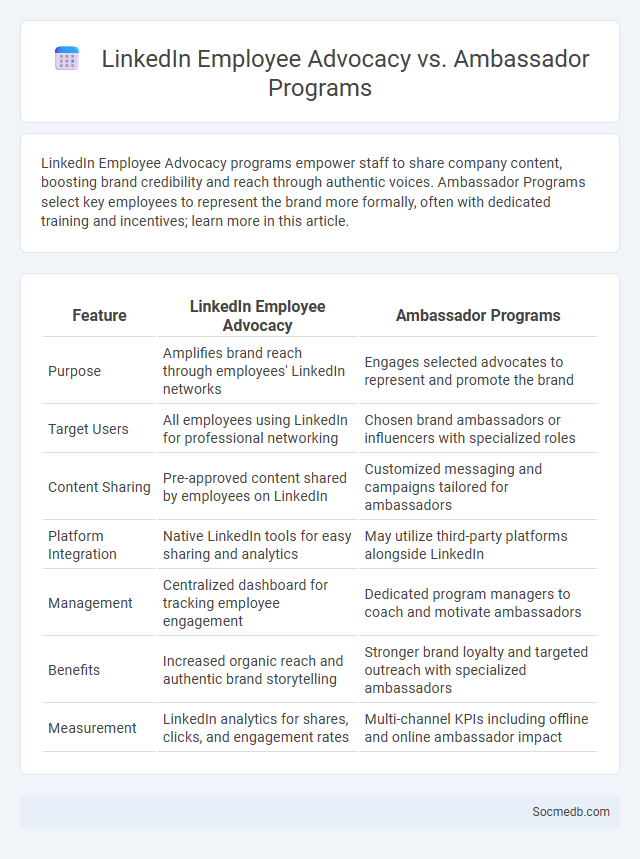
Photo illustration: LinkedIn Employee Advocacy vs Ambassador Programs
LinkedIn Employee Advocacy programs empower staff to share company content, boosting brand credibility and reach through authentic voices. Ambassador Programs select key employees to represent the brand more formally, often with dedicated training and incentives; learn more in this article.
Table of Comparison
| Feature | LinkedIn Employee Advocacy | Ambassador Programs |
|---|---|---|
| Purpose | Amplifies brand reach through employees' LinkedIn networks | Engages selected advocates to represent and promote the brand |
| Target Users | All employees using LinkedIn for professional networking | Chosen brand ambassadors or influencers with specialized roles |
| Content Sharing | Pre-approved content shared by employees on LinkedIn | Customized messaging and campaigns tailored for ambassadors |
| Platform Integration | Native LinkedIn tools for easy sharing and analytics | May utilize third-party platforms alongside LinkedIn |
| Management | Centralized dashboard for tracking employee engagement | Dedicated program managers to coach and motivate ambassadors |
| Benefits | Increased organic reach and authentic brand storytelling | Stronger brand loyalty and targeted outreach with specialized ambassadors |
| Measurement | LinkedIn analytics for shares, clicks, and engagement rates | Multi-channel KPIs including offline and online ambassador impact |
Understanding LinkedIn Employee Advocacy
LinkedIn Employee Advocacy leverages employees' personal networks to amplify company content, increasing brand visibility and credibility. Employees sharing authentic posts generate higher engagement rates, driving organic reach and fostering trust among professional audiences. Effective LinkedIn Employee Advocacy programs include training, content guidelines, and performance analytics to maximize impact and align with corporate branding strategies.
What Are Employee Ambassador Programs?
Employee ambassador programs leverage social media to empower staff as brand advocates, amplifying company messages and enhancing corporate reputation. These programs incentivize employees to share positive content, engage with followers, and expand the company's online reach authentically. Studies show that employee-shared content receives significantly higher engagement rates compared to traditional brand posts, driving increased trust and customer loyalty.
Defining General Employee Advocacy
Employee advocacy on social media involves employees promoting their company's brand, products, or services through their personal profiles, enhancing corporate reach and credibility. Your active participation transforms personal networks into authentic channels for marketing, driving engagement and trust among potential customers. This strategy leverages genuine employee voices to amplify content, boost brand awareness, and foster stronger community connections.
Key Differences: LinkedIn Advocacy vs Ambassador Programs
LinkedIn Advocacy programs leverage your employees' personal networks to amplify company content, enhancing organic reach and credibility through trusted endorsements. Ambassador programs engage selected individuals to proactively create and share branded content, often incentivizing participation to build stronger brand loyalty and visibility. Understanding these differences helps you strategically harness your workforce's influence for targeted social media impact.
Objectives: Elevating Brand Presence on LinkedIn
Elevating brand presence on LinkedIn involves optimizing company profiles with relevant keywords and consistent branding to enhance visibility in industry searches. Engaging regularly through insightful content, employee advocacy, and targeted LinkedIn ads drives deeper connections with key decision-makers and expands professional networks. Leveraging LinkedIn analytics enables continuous refinement of strategies to boost follower growth, increase engagement rates, and position the brand as a thought leader within its sector.
Employee Empowerment: Advocacy vs Ambassadorship
Employee empowerment in social media distinguishes advocacy from ambassadorship by the level of autonomy and alignment with brand messaging. Advocacy involves employees voluntarily sharing positive content about the company, often driven by personal enthusiasm, while ambassadorship entails formal roles where employees are trained and equipped to represent the brand consistently. Your organization can maximize social media impact by balancing authentic employee advocacy with structured ambassadorship programs that amplify trust and corporate values.
Measuring Success: Metrics for Each Approach
Measuring success on social media requires analyzing platform-specific metrics such as engagement rate, reach, and follower growth on Instagram, while Twitter emphasizes impressions, retweets, and hashtag performance. Facebook insights provide data on page likes, post shares, and video views, essential for understanding audience interaction and content effectiveness. LinkedIn analytics focus on lead generation, click-through rates, and profile visits, crucial for B2B marketing strategies and professional networking outcomes.
Tools & Platforms Supporting Employee Advocacy
Social media tools and platforms such as LinkedIn Elevate, Hootsuite Amplify, and Smarp empower employee advocacy by enabling employees to share curated content easily and amplify your brand's message authentically. These platforms offer analytics to measure engagement and optimize campaigns, ensuring Your employee advocacy efforts drive measurable business impact. Integrating these tools with existing communication channels enhances collaboration and strengthens Your brand's online presence through authentic employee voices.
Challenges and Best Practices
Navigating social media presents challenges such as managing privacy concerns, combating misinformation, and maintaining consistent engagement with your audience. Effective strategies include crafting authentic content, utilizing analytics to tailor posts, and implementing clear community guidelines to foster positive interactions. Maintaining your brand's trust and relevance requires continuous adaptation to evolving platform algorithms and user behaviors.
Choosing the Right Program for Your Organization
Selecting the ideal social media management program hinges on your organization's specific goals, available budget, and target audience engagement. Consider platforms offering robust analytics, seamless content scheduling, and multi-channel integration to optimize your marketing strategy. Your choice directly influences brand visibility, audience interaction, and overall digital growth.
 socmedb.com
socmedb.com